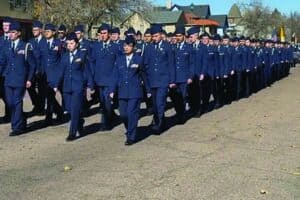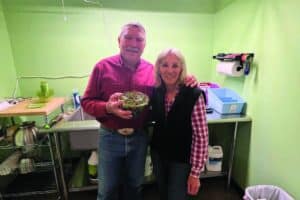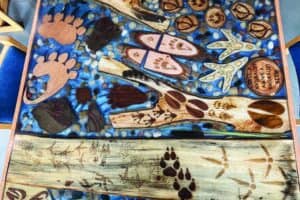Eight years ago, when Greg and Sandy Smith were looking for a business to start in their retirement years, they came across the idea of raising and selling alpacas and their fleece. The Smiths took the plunge in 2004 and haven’t looked back.”We were looking for an animal that was fairly easy to maintain but could produce a pretty good income,” Greg Smith said.Although the Smiths did not grow up on a farm, their families are from a long line of pioneer farmers and ranchers from South Dakota and Nebraska.”It has always been our desire to return to our roots,” Sandy Smith said.The Smiths started with four pregnant females and one male. Now they have a herd of 75 that they manage, while still working full time. Greg Smith works at Peterson Air Force base and Sandy Smith at a nearby defense contractor.They moved to their new 35-acre farm, Black Forest Alpacas, in 2005. The farm is located just west of Falcon, at the end of Raygor Road.For safety purposes, the Smiths have a few llamas, which guard the herd.”For us, dogs and coyotes are the two main threats,” Greg Smith said. Two of their yearling males were attacked by a dog shortly after they started the farm, but the animals survived thanks to quick medical care.Greg Smith pointed to four female alpacas that were staring intently at something in the distance.”One of our neighbors has a pup, and they’re watching that pup over there in the field. They’re just checking him,” Smith said. “A lot of people walk their dogs on the back side of our property. If the dogs are 50 or 100 yards out in front of the people, the whole herd will stop and watch that dog. But if the dogs are up close to the people, the herd senses there is no threat.”Alpacas and llamas are native to South American and members of the camel family, he said. Both easily adapt to living at high altitudes (12,000 to 14,000 feet). “Ninety to 95 percent of their babies are born between 6 in the morning and 2 in the afternoon. That’s a survival mechanism, so the babies (called crias) survive those cold, high altitude temperatures, which makes them well-suited to this area,” Smith said.Compared with horses and sheep, alpacas are low maintenance. “They are probably more similar to beef cattle,” he said. “We give them an annual combined cholera, diphtheria, tetanus shots, worm them once or twice a year, and trim their toenails.”Four years ago, the Smiths imported their first alpacas from South America. Today, the United States has a population of about 140,000 alpacas, which has driven down prices for alpacas and eliminated the need to import.Smith estimated that high-quality pregnant females whose offspring will produce marketable fleece currently sell for $3,000 to $4,000 at the low end and $5,000 to $10,000 at the high end.The Smiths are happy they started an alpaca farm. “It’s extremely rewarding,” Sandy Smith said. “They are cuddly and have a cute factor that’s off the chart.”But alpacas are a little like cats – they want to interact on their own terms. “We probably only have three or four that will come up and let you rub their neck,” Sandy Smith said.The Smiths’ 16-year-old female alpaca, Fritata, was imported from Bolivia and is the only one that will let visitors rub her neck. In fact, “she is probably less friendly with us,” Greg Smith said.The alpacas’ reputation for spitting is undeserved, he added. They spit to let other alpacas know it’s time to back off or get out of the way.”The only time they’ve spit at us is when we got caught between two alpacas or when one was being sheared. Some alpacas don’t like being sheared,” Smith said.The Smiths shear their alpacas on Memorial Day, using a crew of 20-plus professional shearers.The most valuable part of the fleece is the “blanket” that circles the stomach between the shoulders and rump. The fibers are sold to hand spinners who turn the fleece into yarn.The fleece from the legs and neck is shorter and can’t be spun, so it’s less marketable, but a new company is buying the short fibers to make blue jeans mixed with cotton, Sandy Smith said.The fiber is hollow, so it’s lightweight and warmer than wool for the weight, Greg Smith said. The best fleece has a crimp or wave in it, which gives the yarn more loft and body.”There’s almost no lanolin in alpaca fleece, so 80 to 90 percent of people who are allergic to wool are not allergic to alpaca fleece,” he said. The fleece is finer and softer than wool, so for most people, it’s not as itchy.Alpacas and alpaca products from local farms, including the Smiths’ farm, will be on display and available for purchase at the Alpaca Holiday Extravaganza at the Black Forest Community Center Saturday, Nov. 15, from 9 a.m. to 5 p.m. and Sunday, Nov. 16, from 10 a.m. to 4 p.m.For more information about the Smiths’ farm, visit www.blackforestalpacas.com.






